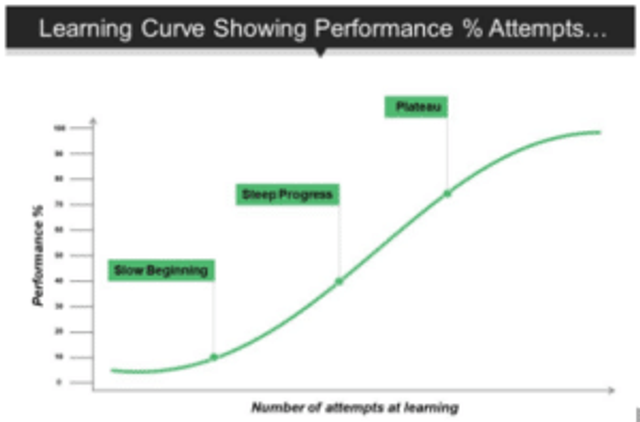
Eddy’s HR Mavericks Encyclopedia
The world's largest free encyclopedia of HR, with 700+ HR articles and podcasts.
Created by Eddy and our HR Mavericks community.
Learning Curve
The idea of a learning curve isn’t new. Organizations can capitalize on this information and reap the benefits of more accurate projections, less staff stress, and an increased production rate.
What is a Learning Curve?
Also called the productivity, efficiency cost, or experience curve, the term “learning curve” refers to the rate a person understands and learns a new skill. There are learning curves for each person developing each new skill. The collection of individual learning curves can be compiled into an organizational learning curve. This can be a graph with the quality of performance on the horizontal axis and the number of attempts on the vertical. Learning curves are never the same and rarely are smooth, perfect curves (we dive into this more in the “Types of Learning Curves” section). Below is a sample learning curve graphic.

Graphic Credit: https://www.slideteam.net/learning-curve-showing-performance-percentage-attempts-graph.html
Why is Understanding the Learning Curve Important for Organizations?
The shape of your organizational learning curve directly impacts the value your organization provides and at what cost. It is important to understand what a learning curve is and how to best support it for each individual. That way, each curve can be nurtured for the best quality outcome. Understanding this is important for:
- Making more accurate projections. Accounting for the learning curve prepares the business for the temporary loss that comes as the staff is getting accustomed to new processes. When not accounted for, the cost of the service or product can be significantly higher than the long-term cost.
- Accelerating the learning curve. Improvements like accelerating the learning curve occur when an organization is proactive through internal and external means.
- Keeping stress and pressure down. When the learning curve is not properly understood, businesses mistakenly project progress and cost in a linear line without taking the human element into account. This inaccurate data can cause an organization to (unfairly) push the staff to exceed their limits for the sake of the bottom line. This leads to poor morale and ultimately increased turnover.
- Improving value and quality. The value of a company is through its people. Therefore the quality of service or products provided by a company directly correlates to the organization’s investment in learning. In order to strategically support learning and improve the overall learning curve, a company needs to have an accurate understanding of how their employees learn best.
Types of Learning Curves
There are four primary types of learning curves.
Diminishing-Returns
This learning curve starts by rapidly increasing, then dropping over time.
Increasing Returns
An increasing returns learning curve takes place when the progression starts slowly but rapidly increases over time.
Increasing-Decreasing Return (the S-curve)
This learning curve describes an employee who begins slowly, rapidly gets the hang of the new skill, then levels off as they meet peak production.
Complex
This learning curve describes a more complex model of learning that requires more extensive tracking.
Methods HR Can Use to Facilitate a Company’s Learning Curve
Help with Goal Setting
The value of goal setting is hard to argue. Encourage short and long-term goals and support employees’ commitment to them. Ensure channels of communication are in place throughout positions and teams so that employees struggling to meet their goals can ask for assistance or insight to get back on track.
Foster Self (and Social) Awareness
Performance never occurs on its own. It’s created by learning, which is largely impacted by understanding how we learn. Creating an environment of self-awareness can increase both the rate at which your staff learns and performance quality. Provide educational opportunities for self-understanding and by extension, others. The more we understand the way our brains work, the more empathy and patience we have towards others. Create opportunities for your staff to evaluate their learning styles and follow up with training specifically geared to capitalizing on the way they absorb new information. Teach them how to work with their peers who process information in dramatically different ways. This not only improves the learning curve but also benefits overall morale, cohesive communication, successful collaboration and general job (and life) satisfaction.
Multiply Motivation Through Development
Piggy-backing off the previous point, ingrain personal development in your company culture. You can do this through the opportunities presented, incentives offered and types of training mandated. Motivating through personal development establishes the belief that further improvements are always possible so long as you are willing to seek them.
Be Flexible
With both your staff and your organization, don’t shirk away from innovations for the sake of familiarity. If you’re not already adopting flexible work arrangements where possible, improving the learning curve is another good reason to do so. Environment and time contribute to learning as much as the method. Different people focus and learn better in different environments. Additionally, everyone has times of day when they absorb information better. Capitalizing on when and where your staff best learns and produces can have a positive impact on their learning curve.
Topics

Kayla Farber
Kayla is the Chief Innovation Officer at Hero Culture, where the passion is to create company cultures of retention using the power of personality.
Frequently asked questions
Other Related Terms
Eddy’s HR Mavericks Encyclopedia
Learning Curve
The idea of a learning curve isn’t new. Organizations can capitalize on this information and reap the benefits of more accurate projections, less staff stress, and an increased production rate.
What is a Learning Curve?
Also called the productivity, efficiency cost, or experience curve, the term “learning curve” refers to the rate a person understands and learns a new skill. There are learning curves for each person developing each new skill. The collection of individual learning curves can be compiled into an organizational learning curve. This can be a graph with the quality of performance on the horizontal axis and the number of attempts on the vertical. Learning curves are never the same and rarely are smooth, perfect curves (we dive into this more in the “Types of Learning Curves” section). Below is a sample learning curve graphic.

Graphic Credit: https://www.slideteam.net/learning-curve-showing-performance-percentage-attempts-graph.html
Why is Understanding the Learning Curve Important for Organizations?
The shape of your organizational learning curve directly impacts the value your organization provides and at what cost. It is important to understand what a learning curve is and how to best support it for each individual. That way, each curve can be nurtured for the best quality outcome. Understanding this is important for:
- Making more accurate projections. Accounting for the learning curve prepares the business for the temporary loss that comes as the staff is getting accustomed to new processes. When not accounted for, the cost of the service or product can be significantly higher than the long-term cost.
- Accelerating the learning curve. Improvements like accelerating the learning curve occur when an organization is proactive through internal and external means.
- Keeping stress and pressure down. When the learning curve is not properly understood, businesses mistakenly project progress and cost in a linear line without taking the human element into account. This inaccurate data can cause an organization to (unfairly) push the staff to exceed their limits for the sake of the bottom line. This leads to poor morale and ultimately increased turnover.
- Improving value and quality. The value of a company is through its people. Therefore the quality of service or products provided by a company directly correlates to the organization’s investment in learning. In order to strategically support learning and improve the overall learning curve, a company needs to have an accurate understanding of how their employees learn best.
Types of Learning Curves
There are four primary types of learning curves.
Diminishing-Returns
This learning curve starts by rapidly increasing, then dropping over time.
Increasing Returns
An increasing returns learning curve takes place when the progression starts slowly but rapidly increases over time.
Increasing-Decreasing Return (the S-curve)
This learning curve describes an employee who begins slowly, rapidly gets the hang of the new skill, then levels off as they meet peak production.
Complex
This learning curve describes a more complex model of learning that requires more extensive tracking.
Methods HR Can Use to Facilitate a Company’s Learning Curve
Help with Goal Setting
The value of goal setting is hard to argue. Encourage short and long-term goals and support employees’ commitment to them. Ensure channels of communication are in place throughout positions and teams so that employees struggling to meet their goals can ask for assistance or insight to get back on track.
Foster Self (and Social) Awareness
Performance never occurs on its own. It’s created by learning, which is largely impacted by understanding how we learn. Creating an environment of self-awareness can increase both the rate at which your staff learns and performance quality. Provide educational opportunities for self-understanding and by extension, others. The more we understand the way our brains work, the more empathy and patience we have towards others. Create opportunities for your staff to evaluate their learning styles and follow up with training specifically geared to capitalizing on the way they absorb new information. Teach them how to work with their peers who process information in dramatically different ways. This not only improves the learning curve but also benefits overall morale, cohesive communication, successful collaboration and general job (and life) satisfaction.
Multiply Motivation Through Development
Piggy-backing off the previous point, ingrain personal development in your company culture. You can do this through the opportunities presented, incentives offered and types of training mandated. Motivating through personal development establishes the belief that further improvements are always possible so long as you are willing to seek them.
Be Flexible
With both your staff and your organization, don’t shirk away from innovations for the sake of familiarity. If you’re not already adopting flexible work arrangements where possible, improving the learning curve is another good reason to do so. Environment and time contribute to learning as much as the method. Different people focus and learn better in different environments. Additionally, everyone has times of day when they absorb information better. Capitalizing on when and where your staff best learns and produces can have a positive impact on their learning curve.
Topics

Kayla Farber
Kayla is the Chief Innovation Officer at Hero Culture, where the passion is to create company cultures of retention using the power of personality.
Frequently asked questions
Other Related Terms
Eddy's HR Newsletter
Sign up for our email newsletter for helpful HR advice and ideas.


